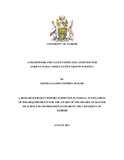| dc.description.abstract | Most organizations are currently focusing on reducing their IT costs, looking for ways to
make IT teams leaner and instead concentrating on remaining competitive in the market by
putting more of their available resources into their core business as opposed to ICT
operations. Therefore, for organizations to compete effectively, they will need IT
infrastructure that can scale quickly to meet dynamic business demands and maximize
utilization of their IT investments. Traditional IT systems have become more complex and
costly to maintain and are no longer able to meet business demands since they lack flexibility
and scalability. Cloud computing is the answer to the problems that are currently being
experienced by organizations that still have the traditional on-premise IT systems. Cloud
computing saves costs by eliminating the need for high infrastructure expenses and also
provides an easy to use, cost efficient, flexible, dynamic and secure environment for
organizations to conduct their business.
A case study was carried out to examine why Agricultural Consultative Groups (ACGs) have
not adopted the Cloud computing technology. The study attempted to find out whether ACGs
understand the concept of Cloud computing, its architecture, what it can offer and associated
risks challenges ACGs might face when migrating their applications to the Cloud. The study
also evaluated the models, architectures, technologies and best practices for ACGs to adopt
Cloud computing and explored available decision/migration frameworks. The thesis then
analyzed specific strategies which ACGs can adopt to ensure that migration and integration
from traditional on-premise systems to the Cloud is seamless.
The determinant factors within each category i.e. individual, organizational, technological
and environmental were then analyzed and classified as high priority, medium priority and
low priority in a Cloud computing framework. From the eleven Cloud drivers that were
analyzed, we can safely say that the most attractive factor when ACGs are making the
decision to adopt Cloud technology is Business Continuity and Disaster recovery capabilities.
From the fourteen concerns and challenges that were analyzed, the main challenges that
ACGs are likely to face when adopting Cloud technology are confidentiality of corporate data
and data security. | en |

